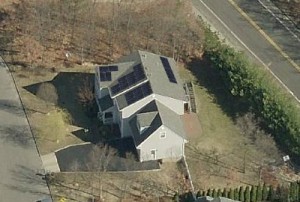Sungevity and Solar Lease
Sungevity is a California company, but does business in NY, kind of. I was attracted to them from their ads on Google search. They boast of being able to design a solar system remotely, without setting their feet on our roof. This is a relief. I cringed a little when the Level Solar rep told us that their people would get on our roof, jump up and down a bit while tethered, to see that the roof can take the extra weight. Well, someone may still have to do that at some point, but at least not before the design is done.
A first hurdle must be overcome. The first person (not the actual sales person/rep yet) from Sungevity I talked with was using Google maps, which did not accurately locate our house, but was pointing to a piece of undeveloped woods. We got better results once I asked him to switch to Bing maps, which also come with very detailed “bird’s eye views”.
I talked with the next person for several hours over two days, and with his manager for more than an hour. At the beginning, while he talked with me, somebody designed the system for us. The talk was not very informative, as I was in no need of convincing on the benefits of Solar. But within half an hour, two designs were presented for me to review. As it turned out, their design team actually was using Bing maps, and the outcome was pictures of solar panels overlaid on the bird’s eye views of Bing maps. Alas, the online maps are not that detailed, and I’m afraid that when they come to install the system the design must be adjusted.

 When I looked at the two designs, I wasn’t very happy about either one. I asked for an alternative design where the solar panels were all on the back of our house, for better aesthetics. Soon that was accomplished. Because the back of the house faces east, while some of the front panels were placed towards south, this design needed more solar panels to generate the same electricity, and therefore was more expensive, but only by 2.3%.
When I looked at the two designs, I wasn’t very happy about either one. I asked for an alternative design where the solar panels were all on the back of our house, for better aesthetics. Soon that was accomplished. Because the back of the house faces east, while some of the front panels were placed towards south, this design needed more solar panels to generate the same electricity, and therefore was more expensive, but only by 2.3%.
Sungevity website gave a very nice graphical interface to play with the different financing models. The available choices include the different designs (three in our case), buy or lease, and if lease, how much down payment is desired. Unfortunately, the conditions of each financing option are not spelled out on the page, not even in digest. I was most intrigued by the comparison of the buy option and the prepaid lease option.
The buy option is more expensive, but I get to eventually deduct the federal tax credit, at 30%. In addition, I also get the $0.20 per KW credit from NY-Sun initiative. The prepaid lease option gives me the same system with less up-front out-of-pocket expenses, but I lose the two credits above. I could also choose a low- to no-down payment lease option, but that turned out to be a finance deal with approximately an 8.7% interest rate—which I only found out much later, when I got the contract and did the calculations.
Whether I buy or lease has no bearing on the service I get. In both cases I get 20 years of monitoring and performance guarantee by Sungevity, the same software for myself to monitor the production from the system, and the same 20 year warranty on the equipment.
Over the next two days, I had discussions with the sales person (the rep) and his manager. The questions I had and they answered were mainly these:
Residual value
The reason I chose the prepaid lease plan was that I was convinced that after 20 years I get to keep the system for free, which gives this plan the same outcome after 20 years, but with lower out-of-pocket expense. The representative even helpfully shared with me a page from someone else’s contrast, showing the depreciation table of the equipment, and after 20 years the buy-out price of the system was indeed $0.
But unfortunately, when I got our own contract, this table was nowhere to be found. On the contrary, the contract clearly spells out that at the end of the term “Sunrun will remove the Solar Facility at no cost to you.” The contract mentions Sunrun a lot, and the rep’s explanation is that Sunrun is the financier, while Sungevity is the service provider. I’m not sure I can buy that, given the contract language to the contrary, but I was willing to overlook the difference—as long as someone is there on the other side of the contract, I can forgive the switching of entity. But taking a promised value away is not something I can freely forgive.
With this term change, all of a sudden the prepaid lease option becomes a lot less attractive than the purchase option. At this point I felt very much cheated, because if they only disclosed ahead of time this important detail, I would not have given them the permission to run my credit report—for if I am to buy the system, there really is no need for it, is there?
Performance Guarantee
The contrast says, and the rep happily paraphrased, that, for our “peace of mind”:
- “Sunrun offers a Performance Guarantee. If your system does not produce the power output guaranteed in this agreement, we’ll refund you for lost power.”
- “If your system overperforms you keep the excess power free of charge.”
But when I got the contract, the performance guarantee is pretty empty. Firstly, it pays me $0.13 per KWH for under-production. When I asked why it was so low, the rep had the audacity to tell me that I’m so lucky that I had locked in a great low rate! “No, you’ve locked in a great low rate, not me! I still have to buy the electricity from my utility company at $0.20 or so”. Then he took another tack: “Now you’re going down a rabbit hole! You’re behaving as if we couldn’t make the amount of electricity as promised.” To that my answer was: “Well, it’s really you who don’t believe in your numbers! If you do, you could guarantee under-production at any rate!” There were other arguments presented, which were even less persuasive or upright, and I’ll not mention them here.
The other problem with the performance guarantee is that it lists cumulative production rather than per year. When I asked, I was told that over-production from any year is reset at the end of the year, and not rolled over to the next. This would have been nice, and would have agreed with their ad-speak at the top, the part about “you keep the excess power free of charge”. Well, in careful reading one finds the exact wording in the contract as this: “Sunrun may use this overproduction amount (kWhs) to offset future underproduction.” This is the exact opposite of what the rep told me!
As such, there is no such thing as “you keep the excess power free of charge.” To begin with, one can’t keep excess electricity. It goes to the utility, and the utility pays me bulk rate, about $0.04-$0.05 per KWH. Then in the following year, if there was an under-production, I’d buy the electricity from the utility company at their retail rate, currently at about $0.20/KWH.
The rep’s manager offered me $500 off, if I could sign the contract that night. I said that my wife was in bed already. He told me that “you could sign for her”. Since we’re talking about electronic signature, it would not look any different. But that sounds illegal to me.
I have not fully given up on Sungevity, neither have they on me.